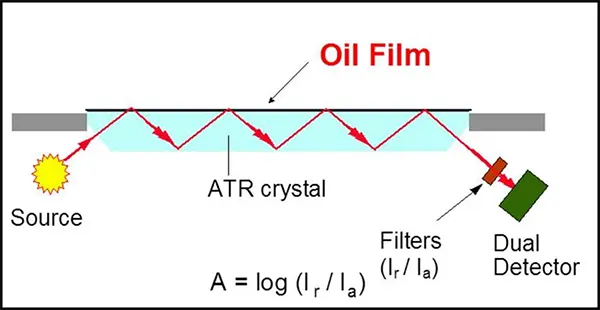The InfraCal Model ATR-SP is recommended for measuring oil in water, TPH in soil or FOG in wastewater concentration levels when using hexane, pentane or Vertrel MCA as the extracting solvent. Measurement data obtained with this analyzer will correlate to EPA Method 1664 as both procedures are based on evaporation techniques and measuring the residual oil and grease. The analyzer is equipped with a built-in cubic zirconia horizontal attenuated total reflection (HATR) stainless steel sample stage. The InfraCal 2 ATR-SP is a direct replacement for the original InfraCal HATR-T2 used worldwide for the determination of TOG/TPH in water and soil.
- Minimum Detection Limit Water: 0.3 ppm
- Minimum Detection Limit Soil: 3 ppm
- Method Compares: EPA 1164 & ISO 9377-2
- Solvents: Hexane, pentane, cyclohexane & Vertrel MCA
As offshore oil wells age, the increase of produced water challenges wastewater treatment systems. In order to ensure oil levels in the water are under the regulatory limit, it is important to do regular testing. Infrared analysis has been used for off-shore oil in water measurements for over 45 years. Infrared is an accepted oil content measurement as it is least affected by changes in produced water composition.
For industrial pretreatment of wastewater and public water treatment plants a simplified procedure for monitoring FOG discharges can avoid fines, sanitary sewer overflows (SSOs) and give on-site results in less than 15 minutes rather than waiting days or weeks for an off-site laboratory result.
The InfraCal 2 has added features such as touch screen display, data storage and transfer, a multi-language interface and password protected settings. The internal battery pack allows for portability and up to 6 hours continuous use.
Click here to view the ATR-SP FAQs
Operating Principle
The InfraCal 2 ATR-SP analyzer is designed to measure solvent extractable material (oil and grease) by infrared determination in water or soil using hexane, pentane, cyclohexane or Vertrel MCA for the extraction procedure. A detector with a fixed 3.4 μm (2940 cm-1) filter is used to measure oil and grease concentrations. The ATR-SP correlates with EPA Methods 1664 as well as with the ASTM D7066 Method and EPA 413.1 and 418.1.
The ATR-SP makes use of the fact that oil and grease can be extracted from water or soil through the use of an appropriate solvent and extraction procedure. The extracted hydrocarbons absorb infrared energy at a specific wavelength and the amount of energy absorbed is proportional to the concentration of hydrocarbons in the solvent. The analyzer can be calibrated to read out directly in the desired units such as %, ppm, mg/L or mg/kg.
The touchscreen display includes the capability for multiple calibrations, a wizard guide for calibration, multilevel user database, multiple languages with user preference selection, high/low alarm and control limits, and measurements stored in a history table for recall or export to a flash or serial port.

Specifications
| Item | Specifications |
| Analytical Wavelength/Wave Number | 3.4 µm, 2930 cm-1 |
| Power Requirements | 18 volts DC, 3.3 amps, internal battery pack available |
| Power Supply | Universal AC/DC provided |
| Weight | 5.8 lb. (2.6 kg) with battery -7.0 lbs (3.2 kg) |
| Dimensions | (17 cm) x 7.8″ (19.8 cm) x 5.2″ (13.2 cm) |
| Suggested Operating Range | 5°C – 40°C |
| Measurement Range | |
| For Water | 0.3-2000+ ppm 0.3-15+% |
| For Soil | 3-2000+ ppm 0.3-15+% |
| Analysis Time | 10-15 minutes, including extraction process |
| Instrument Repeatability | ±0.3 ppm |
| Communication Port | USB |
New High Range Measurement of Oil In Water or Soil
The InfraCal 2 analyzer with an ATR sample stage can now be used for measuring the 0.5-10% range of oil in water or soil. The sample is extracted using a solvent that does not have an infrared absorbance at the hydrocarbon wavelength and, therefore, does not require evaporation. Measuring the extract directly in the solvent, instead of evaporating off the solvent, allows for percent range measurements with the same ATR sample stage used to measure the ppm levels.
- Measurement Range Water: 0.5 – 10%
- Measurement Range Soil: 0.5 – 10%
- Solvents: S-316, Tetrachloroethylene





